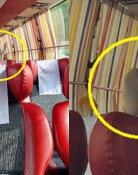China's sandstorms hit Korea with fine and yellow dust
China's sandstorms hit Korea with fine and yellow dust
Posted November. 28, 2018 07:38,
Updated November. 28, 2018 07:38
Tuesday was indeed a suffocating day in Korea as smog and yellow dust originated in China were added to the accumulated fine dust in the atmosphere. It is the first time this fall yellow dust affected the Korean Peninsula.
According to the Korea Meteorological Administration and the National Institute of Environmental Research, the ultra-fine particle concentration level was "bad" with 48μg per m³ as of 3:00 p.m. Tuesday. An ultra-fine dust watch was issued at 10:00 a.m. and 12:00 p.m. in Gyeonggi Province and Incheon City, respectively. A watch is issued when ultra-fine dust that exceeds 75μg per m³ lasts for more than two hours. As the atmosphere of the Korean Peninsula has stagnated since Friday, fine dust generated within Korea has been accumulated, added with smog from China, making find-dust even more concentrated.
To make matters worse, yellow dust also overlapped with the current atmospheric situation. It has been six months since yellow dust inflowed into Korea after May 25. Part of the yellow dust that was generated near Mongol in China on Monday blew into the Yellow Sea through northwest wind and affected the Korean Peninsula from Tuesday afternoon. Yellow dust that flew into Korea from China were fine dust of which PM diameter is more than 2.5μm but less than 10μm, meaning it has larger particles than ultra-fine dust of which the PM 2.5 diameter is less than 2.5μm.
Chul-Jung Kim tnf@donga.com







